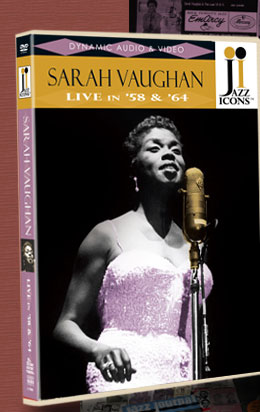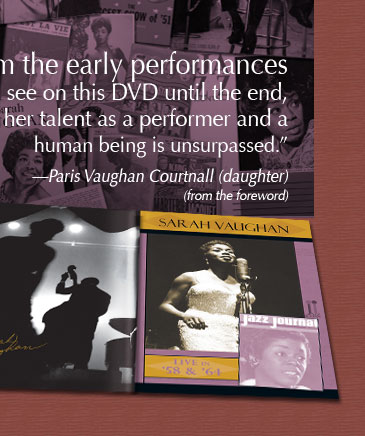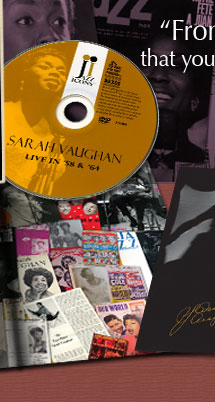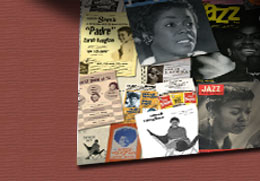




 |
 |
|
|||
|
|
|
||||
|
|
|
||||
|
|
|
||||
|
|
|
||||
 |
|
||||
 |
|
||||
 |
|
||||
|
|
|
|
|
|
|
Jazz Icons: Sarah Vaughan features the "Divine One" in her prime, wrapping her sultry voice around jazz standards such as "Lover Man", "Misty" and "I Got Rhythm and soaring on popular showtunes such as "Over The Rainbow" and "Maria". One of the greatest voices of the 20th Century, her renditions of songs by Harold Arlen, Leonard Bernstein, Johnny Burke, the Gershwins and Stephen Sondheim are pure diva magic. These three performances demonstrate why Sarah Vaughan is invariably mentioned in the same breath as Ella Fitzgerald and Billie Holiday. |
|
 |
|
|
Sarah Vaughan (Vocal) Richard Davis (Bass) Ronnell Bright (Piano) Art Morgan (Drums) |
|
 |
|
|
Sarah Vaughan (Vocal) Richard Davis (Bass) Ronnell Bright (Piano) Art Morgan (Drums) |
|
 |
|
Sarah Vaughan (Vocal) Buster Williams (Bass) Kirk Stuart (Piano) George Hughes (Drums) |
|
|
|
|
|
Foreword: Growing up with my mom was probably pretty similar to any other childhood. However, there was one big difference…I had to share my mom with millions of people whom I did not know and who all claimed to love her just as much. But they knew a different Sarah Vaughan. Sarah…Sassie…Mom. She was all of them rolled into one beautiful woman. It was a very rare occasion when the three crossed paths. Mom is the one I knew best and will carry in my heart for the rest of my life. ... From the early performances that you see on this DVD until the end, her talent as a performer and a human being was unsurpassed. I hope you enjoy watching these performances as much as I did. They really capture the young Sarah before the Sass. She’s sweet and sultry with her youthfulness shining through. She is truly the “Divine One.” —Paris Vaughan Courtnall
Sample Liner Notes by Patricia Willard: Sarah Vaughan arguably was the most phenomenal singer of her century. Musicians loved her. Most were in awe of her. All respected what they almost unanimously agreed was her innate musicality. “She was born with a gift,” insisted towering blues and ballad singer Joe Williams. “She sings like a horn,” John Birks “Dizzy” Gillespie praised. “She can sing notes that other people can’t even hear.” Unlike many of her contemporary divas, she was reared the only child in a stable, religious, strict and loving home in Newark, New Jersey. Her father, Asbury “Jake” Vaughan disapproved of show business. Her mother, who sang with Sarah in the Mt. Zion Baptist Church Choir, was more understanding. Sarah absorbed essential musical grounding through piano and organ lessons from the ages of seven to fifteen. At twelve, she became one of Mt. Zion’s regular organists. ... The Swedish television program on this DVD was filmed following a month-long engagement at Cité Varieté in downtown Stockholm, according to the Swedish newspaper Estrad and Göran Wallén, now a concert impresario in that city. Johnnie Garry, Sarah’s road manager since they met during her 1946 gig at Barney Josephson’s fabled Café Society Downtown, was coordinating the European itinerary. Johnnie delighted in everything about his job. Sarah not only depended upon his efficiency, she relied on his judgment so completely that she accepted his edict that her stage wardrobe must be exclusively white. “She had her choice of what she would wear,” he said, “but we convinced her about white.” This facilitated his creating dramatic visual effects as she sang. “In those days, it wasn’t computer lighting,” he relates. “You had levels you could hold if she wanted to slow down. You could never know what Sarah was going to do—except you couldn’t write cues...If she sang something up-tempo, we’d brighten it up a little bit. On ‘Mean To Me,’ for example, we’d focus around her with some little medium red and blue and a little straw. We’d use the same pink spotlight on her face but we could fade out on her face if that was the mood. Her white wardrobe allowed us to project a pink face with a blue gown if that expressed what she was singing. Sarah had to trust you. She didn’t like people who couldn’t think for themselves. ... For this DVD release, Quincy took time from his third globe-circling in three-and-a-half months to call from Dubai, where he was working for the Quincy Jones Listen Up Foundation. His organization is concerned with urgent world health issues and connects underprivileged youth with technology, education, culture and music internationally. “This DVD is so important. Today’s kids must be exposed to their cultural heritage, and Sarah...we go w-a-a-a-a-a-y back...I must have met her when I had my big band in New York in 1953 or ’54...They were our idols—Miles, Dizzy, Bird, Sarah.” Back in the States, within three months, Sarah recorded another of her many collaborations with the Count Basie band. About that date, Benny Powell reminisces, “Sarah was a wonderful person, so easy to be around. I loved doing dates with her. She made everything so comfortable. That’s why her performances then are still so good now. She set up an atmosphere of just pure joy and a kind of freedom so when you got to Sarah Vaughan’s record dates, she was so very well prepared, we never did many takes. Her artistry inspired everybody to be as good as they could possibly be.” ... On the first of the three television programs in this collection, this broadcast on Swedish TV, thirty-four-year-old Sarah Vaughan is in her ingénue mode, somewhat shyly but bravely announcing what she will sing. Sweetly demure in a non-Garry-approved dress, she offers a new reading of “Sometimes I’m Happy”, the Leo Robin-Clifford Grey-Vincent Youmans song she first recorded on October 25, 1955. Certain numbers appealed to her so strongly, suggesting tantalizing new paths, that she not only kept them in her live repertoire, but she also called them repeatedly at recording sessions—this one on six occasions. “Lover Man”, as she explains, holds perennial significance, transporting her to her debut with Parker and Gillespie. Co-composer Roger “Ram” Ramirez (with Jimmy Davis and Jimmy Sherman), upon hearing that first recording of his tune, has been quoted that Diz and Bird “needed a creative singer like Sass to make them sound appealing.” Here, she is very much the leader, subtly supported with just essential chords by Bright and Davis, and Morgan’s delicate brushwork. “September in the Rain” is relatively new to her repertoire but obviously energizing to the trio. Davis’s grin is as expressive as his pizzicato. Her At Mr. Kelly’s plug is for the live album she made with Davis less than a year earlier at the Chicago club. The Al Dubin-Harry Warren standard apparently did not meet her criteria for permanence. She recorded it only once. ... “Misty” is serendipitously Sarah’s. “Erroll Garner caught me getting on the plane,” Quincy Jones relates. “Johnny Burke had just written lyrics to Erroll’s ‘Misty,’ and Erroll said, ‘Stick this in your pocket because I like the lyric—Look at me, I’m as happy as a kitten up a tree…’ and I just stuck it in my pocket and showed it to Sarah when I got to Paris, and we just did it. She loved it immediately. We both did. That was 1958, and we had the first record on ‘Misty’. On the same date, Vaughan And Violins, Sarah sang my ‘The Midnight Sun Will Never Set’. I had written that with Henri Salvador for the Harry Arnold band in Sweden and [alto saxophonist] Arne Domnérus. Sarah heard it at their Stockholm concert and asked me to get a lyric for her so Dorcas Cochran and I wrote words especially for Sass. We made ‘Misty’ again with her trio for Sassy Swings The Tivoli at Copenhagen in 1963. ‘I Feel Pretty’, ‘Lover Man’, ‘Sometimes I’m Happy’, ‘Tenderly’, ‘Honeysuckle Rose’ and ‘Bill Bailey, Won’t You Please Come Home’ are on that record, too, so it’s great that I can see her sing them all again on her Jazz Icons DVD.” Here, Sarah thanks her audience in Swedish for their applause as she approaches “Misty”. ... —Patricia Willard All words and artwork on this page ©Reelin' In The Years Productions. Unauthorized use is prohibited.
|
|
Site contents ©Copyright 2007 Reelin' In The Years Productions
Site designed by Tom Gulotta